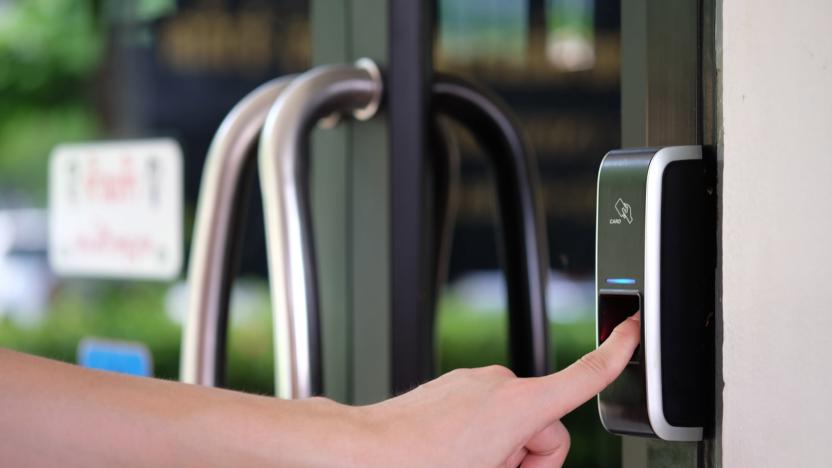fingerprints
Latest

Kenya halts biometric ID scheme over discrimination fears
Kenya introduced a sweeping national biometric identity program last year, with the view to collecting personal and biometric data -- such as fingerprints and facial photographs -- from its 50 million-strong population. Now, however, the program has been temporarily suspended by the country's high court, which has cited concerns about the way the data may be used.

The Pentagon has a laser that identifies people by their heartbeat
Biometric identification has become part of everyday life. We've got facial recognition in airports, cars that can be unlocked just by looking at them, technology that detects a person's unique way of walking, and of course the ubiquitous fingerprint, used for everything from smart phones to event ticketing. Next on the agenda? Your heartbeat.

AI can create synthetic fingerprints that fool biometric scanners
Researchers from New York University have found a way to produce fake fingerprints using artificial intelligence that could fool biometric scanners (or the human eye) into thinking they're the real deal. The DeepMasterPrints, as the researchers are calling them, replicated 23 percent of fingerprints in a system that supposedly has an error rate of one in a thousand. When the false match rate was one in a hundred, the DeepMasterPrints were able to mimic real prints 77 percent of the time.

Uber and Lyft may not have to fingerprint drivers in California
Ride-sharing companies Uber and Lyft have had some issues with driver background checks over the years. More than 8,000 drivers from both companies failed checks in Massachusetts this year, while Uber was reported to have missed criminal records as far back as 2015. Uber was sued in California over misleading statements around rider safety last year, and both companies promised to leave Austin if fingerprint checks were required. This week, the San Francisco Chronicle reported that the ride-hailing services would avoid fingerprint checks in California. Instead, the California Public Utilities Commission proposed that Uber and Lyft would instead have to ensure that background checks are done by an accredited vendor on an annual basis.

Facial recognition will replace passports in Australia
Australia has started implementing biometric facial, iris and fingerprint recognition in airports, allowing passengers to go through without showing a passport or even talking to anyone. The "Seamless Traveler" project is aimed at creating a "fast, seamless self-processing experience for up to 90 percent of travelers," so that border control can focus on high-risk passengers. The handy, but invasive-sounding plan would allow international travelers to "literally just walk out like at a domestic airport," security analyst John Coyne told Australia's Sydney Morning Herald.

Access granted: Mobile security at the touch of a finger
Whether spurred by work regulations or the desire for personal data security, many of us spend more time than we'd like entering PIN codes and passwords to access our devices. Biometric authentication tools, specifically fingerprint sensors, can help us reclaim those moments by providing access with the touch of a finger. The technology isn't new, but it's only in the past few years that it's started to become standard on mobile devices. This week, we trace the ascent of the fingerprint sensor, from its early days as a peripheral to the embedded technology that's simplifying and securing our mobile lives.

Yankee Stadium to fans: Scan your thumb and skip the line
Welcome to the future, sports fans – you can use your smartphone to track trades, Twitter can tell you who's on the DL, and now your fingerprints can get you into the ballpark faster. Beginning August 7th, Yankee Stadium will roll out the Clear biometric security service to visitors, which allows fans to use a "Fast Access" line by registering their fingerprints and driver's licenses.

You only need a camera (and luck) to copy someone's fingerprints
Forget having to lift smudges from a touchscreen to copy someone's fingerprints. According to a Chaos Computer Club presentation, you only need a camera... well, that and a little luck. The hacking association's Jan Krissler recently demonstrated that you can reproduce someone's fingerprint by getting a few good photos of their hand and processing it through off-the-shelf authentication software like VeriFinger. In Kessler's case, he got the German Defense Minister's thumbprint through photos from a press conference.

Coming soon: laptops with fingerprint sensors built into the touchpad
At some point -- probably when the iPhone 5s came out -- fingerprint sensors became cool. Yes, they've been used on business laptops for years, but it's only recently that we've started to see them in stuff consumers would buy -- things like smartphones and tablets. Now, it seems, we're coming full circle. Synaptics, the leading maker of laptop trackpads, just announced something called the SecurePad, a touchpad with a fingerprint sensor built into the upper-left corner. Unlike existing fingerprint scanners for laptops, which require users to swipe their fingers over the sensor, this one uses capacitive touch, similar to the fingerprint modules used in devices like the iPad mini 3 and Galaxy S5. The result should hopefully be a more reliable experience than you would have gotten on older-gen laptops, but as we've seen with newer products, even touch-based fingerprint scanners can be a mixed bag.

New MasterCard combines a fingerprint sensor with NFC
For awhile now, there's been a number of companies trying to simplify payments for everyone. Google did so with Wallet and, most recently, Apple announced it would be doing something similar with the soon-to-be-launched Apple Pay, among others. Not surprisingly, MasterCard's, synonymous with paying for stuff, is working on a product of its own. In partnership with Zwipe, a company that focuses on biometric tech, MasterCard has built a charge plate with a built-in fingerprint sensor and NFC, albeit for trial purposes. The Zwipe MasterCard, as it is currently known, is said to be extremely secure -- all data is stored directly on the card, rather than an outside database, for example.

Apple files patent application for fingerprint sensor that can be transparent or opaque
While Apple has flirted with biometric-based patents before, we've yet to see them implemented in real-world technology. That hasn't stopped it from filing yet another one though, as the latest application reveals a fingerprint sensor apparently embedded into the iPhone itself. The patent describes a hardware "window" that can become selectively "transparent or opaque." When transparent, it would reveal a component comprised of an "image capture device, a strobe flash, a biometric sensor, a light sensor, a proximity sensor, or a solar panel, or a combination thereof" as a method of unlocking the phone. According to the filing, the biometric sensor in question might indeed be a fingerprint reader. The document goes on to describe an alternative method using face or eye recognition technology that can be used not just for security purposes, but for possible e-commerce solutions like completing an online transaction. Of course, take any of these patent applications with a generous pinch of salt -- we haven't seen an Apple stylus yet, for example -- but perhaps this is the reason Apple bought fingerprint sensor maker AuthenTec back in July.

iPad apps produce unique fingerprint patterns
You may have seen click heatmaps before -- they're a visual representation of where user mice have clicked on a web page. The iPad, as this post from Design Language News shows, has its own built-in heatmap: the oils and residue left on the iPad's screen after you use a certain app. It's kind of gross, sure (usually, people are more concerned about wiping this stuff off than learning anything from it), but as you can see from the pictures, the fingerprints can provide some interesting insight into apps and how they're used. You can see, for example, why the iOS UI puts rarely-used or navigation buttons on the top of the screen. Since most of our usage is right around the middle, developers want to make sure that buttons that require any traveling also have a suitable importance of function and thus are prominently displayed. And you can see the simplicity of certain apps, too, as Angry Birds and the YouTube app only have a few controls, while a game like Fieldrunners can get relatively complex. Interesting stuff, all divined from smudges we wipe off daily. I don't think Apple provides heatmaps like these to developers, but maybe some coders trying to figure out how their UI is used can check the fingerprints after a usage session and see what they learn. [via Waxy]

Nintendo DSi XL review
Since Nintendo first asserted sole domination over the handheld gaming market with the release of the paperback-sized Game Boy in 1989, the company has striven time and again to make its pocket systems smaller, meeting fantastic financial success along the way. Nintendo did it with the Game Boy Pocket, the Advance SP, the Micro, the DS Lite and again ever so slightly with the DSi -- the last even at the expense of backwards compatibility and battery life. Now, for the first time in the company's history, it's made an existing platform bigger, with questionable reasons as to why. Does the Nintendo DSi XL squash its predecessors flat? Or is Nintendo compensating for something? Find out inside. %Gallery-89058%

Hitachi builds 3mm-thick vein scanner in its Transylvanian lair
Hitachi has always been hot for vein authentication modules, and its latest iteration takes the whole tech down to just three millimeters in thickness. Given that the current generation requires 23.5mm (nearly an inch) of space to operate in, it's easy to see why your netbook doesn't have one, but Hitachi hopes that's all about to change. Using a CMOS sensor to take almost instant readings, the vein scanner is deadly accurate -- there's only a one in a million chance of it authorizing the wrong person. Volume production is expected within two years, meaning that by 2011 you'll finally have a reliable way to keep your parents out of your "Misc" data folders.

Recent Apple patent filing speaks of stealth biometric security on iPhone, other insane insanity
Recent patent fillings by Apple that AppleInsider has dug up point to the company adding several new methods of insuring the security of its devices for users. The new filings cite biometric authentication methods that would excite Ethan Hunt -- including installation of a hidden sensor behind the screen that would recognize the user's fingerprint when touched, and / or a front-facing camera for retinal recognition. The filing also suggests further possibilities, such as the device being capable of recognizing the user's voice, or collecting DNA samples for recognition via genetic code. We've heard plenty of semi-speculative tech tales in the past, so we always take this stuff with a grain of salt, but Apple seems to be moving forward at least into the research phase of such endeavors. To the future we go! There's one more fantastic scribble after the break, hit the read link for more details.

Amsterdam Arena to bar troublemakers via fingerprint scans
It looks like those crazed individuals who somehow managed to escape from the nation's video game addict rehab center won't be sneaking into major football events to stir up trouble anymore, as Amsterdam Arena has launched a trial program to scan the fingerprints of football fans before letting them enter as they try to better "exclude known troublemakers" from making it to the stands. While European soccer football matches are known to elicit tremendous passion from both parties, oftentimes resulting in violent behavior, the biometric scanners will hopefully curb the conflicts as it better enforces bans to precious offenders. Reportedly, the system will initially be at home games of Ajax, Feyenoord and Vitesse, and if it seems to go over well (read: enraged fans chill out), it could be rolled out in a few more locales later this year.[Via BBC, thanks Stewart D.]

Elecom CR-FP2, yet another biometric flash drive
If you're looking for an alternative to the Pretec i-Disk Touch USB flash drive or to the smartSTIK-MD, and find yourself in the Land of the Rising Sun, you may want to check out the new Elecom CR-FP2 biometric flash drive. From what we can tell, it's a pretty standard half gig drive that will encrypt your data such that it can only be unlocked by way of a fingerprint scan. It can be yours for ¥8,820 ($76) sometime later this month -- just make sure you don't get in a fight with some Yakuza and lose a finger or two before then.[Via PC Watch]

Lenovo ThinkPads bring biometric HDD encryption, Merom, and draft-N
While fingerprint scanners on laptops are becoming all the rave lately, from what we can tell most of them don't encrypt and decrypt data with the swipe of a finger. Today, Lenovo announced that all new models in the ThinkPad 60 series will include Ultimaco's SafeGuard Easy 4.30, software which enables the option of biometric hard drive encryption that meets the FIPS 140-2 certification -- what the Feds require for government-purchased encryption products. On the Core 2 Duo side, models T60, T60p, R60, R60e, X60, Z61t, Z61p and Z61e are getting the bumped processor treatment, while the same laptops, plus the X60s, (but not including the Z61e) are also to be offered with 802.11n. Lenovo told us that all of these new features are due out later this month, but we don't yet know how much of a premium they'll fetch; we'll keep you posted as soon as the intel comes in. [Via The Associated Press]

Digital fingerprint door lock defeated by photocopied 'print
There's an old adage in the security community that any lock can be picked. Well in this modern age of digital doorlocks with fingerprint scanners, you can't exactly pick them with a bump key, nail file or other such assorted tools, now can you? Luckliy for budding criminals, the smart cats on "Mythbusters" discovered that one of these "never been broken" digital fingerprint scanner locks (they didn't cite the manufacturer) -- which also comes with thermal sensors (to detect if there's a real human behind that print) -- can in fact be quite easily duped. So how'd they do it? By copying the master fingerprint onto a piece of latex and attaching it to his thumb, Adam Savage was able to open the lock without a problem. Savage and his team then duplicated the feat by making another copy with ballistics gel. And to top it all off, they did it a third time (check the video link below) with a just a photocopy of the master fingerprint and a little saliva. Perhaps our own Marc Weber Tobias should have a word with the makers of these schlocky locks.










